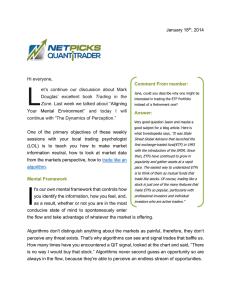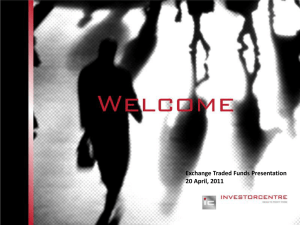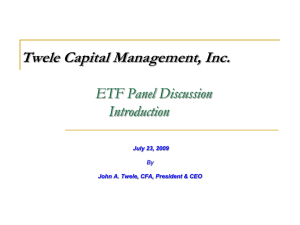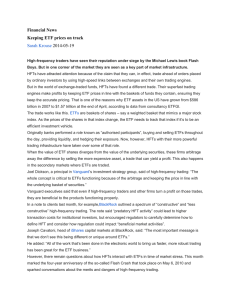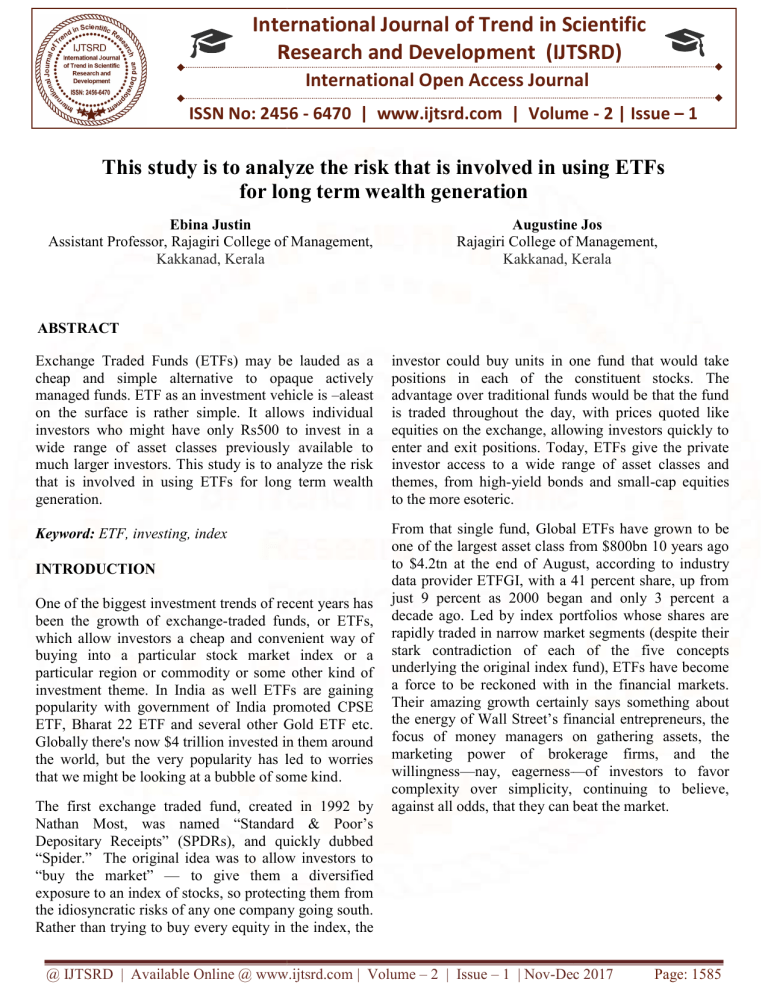
International Journal of Trend in Scientific
Research and Development (IJTSRD)
International Open Access Journal
ISSN No: 2456 - 6470 | www.ijtsrd.com | Volume - 2 | Issue – 1
This study
tudy is to analyze the risk that is involved in using ETFs
for long term wealth generation
Ebina Justin
Assistant Professor, Rajagiri College
ollege of Management,
Kakkanad, Kerala
Augustine Jos
Rajagiri College
ollege of Management,
Kakkanad, Kerala
Keral
ABSTRACT
Exchange Traded Funds (ETFs) may be lauded as a
cheap and simple alternative to opaque actively
managed funds. ETF as an investment vehicle is –aleast
on the surface is rather simple. It allows individual
investors who might have only Rs500 to invest in a
wide range of asset classes previously available to
much larger investors. This study is to analyze the risk
that is involved in using ETFs for long term wealth
generation.
investor could buy units in one fund that would take
positions in each of the constituent stocks. The
advantage over traditional funds would be that the fund
is traded throughout the day, with prices quoted like
equities on the exchange, allowing investors quickly to
enter and exit positions. Today, ETFs give the private
investor access to a wide range
rang of asset classes and
themes, from high-yield
yield bonds and small-cap
small
equities
to the more esoteric.
Keyword: ETF, investing, index
From that single fund, Global ETFs have grown to be
one of the largest asset class from $800bn 10 years ago
to $4.2tn at the end of August, according to industry
indus
data provider ETFGI, with a 41 percent share, up from
just 9 percent as 2000 began and only 3 percent a
decade ago. Led by index portfolios whose shares are
rapidly traded in narrow market segments (despite their
stark contradiction of each of the five concepts
underlying the original index fund), ETFs have become
a force to be reckoned with in the financial markets.
Their amazing growth certainly says something about
the energy of Wall Street’s financial entrepreneurs, the
focus of money managers on gathering
ga
assets, the
marketing power of brokerage firms, and the
willingness—nay, eagerness—
—of investors to favor
complexity over simplicity, continuing to believe,
against all odds, that they can beat the market.
INTRODUCTION
One of the biggest investment trends of recent years has
been the growth of exchange-traded
traded funds, or ETFs,
which allow investors a cheap and convenient way of
buying into a particular stock market index or a
particular region or commodity or some other kind of
investment theme. In India as well ETFs are gaining
popularity
arity with government of India promoted CPSE
ETF, Bharat 22 ETF and several other Gold ETF etc.
Globally there's now $4 trillion invested in them around
the world, but the very popularity has led to worries
that we might be looking at a bubble of some kind
kind.
The first exchange traded fund, created in 1992 by
Nathan Most, was named “Standard & Poor’s
Depositary Receipts” (SPDRs), and quickly dubbed
“Spider.” The original idea was to allow investors to
“buy the market” — to give them a diversified
exposure too an index of stocks, so protecting them from
the idiosyncratic risks of any one company going south.
Rather than trying to buy every equity in the index, the
@ IJTSRD | Available Online @ www.ijtsrd.com | Volume – 2 | Issue – 1 | Nov-Dec
Dec 2017
Page: 1585
International Journal of Trend in Scientific Research and Development (IJTSRD) ISSN: 2456-6470
2456
Literature Review
Markus Stadlmann, chief investment officer of Lloyds
Private
vate Bank, agrees that this automatic buying activity
is a problem. “[It’s] obviously wrong because it takes
the valuation of the companies to a level that is not
appropriate, and it also opens up the stocks to
arbitrage.”
Steven Bregman, the co-founder
founder of US-based
investment adviser Horizon Kinetics, is critical of the
distortions being created by the rise of ETFs. “There is
a law of supply and demand, and if something gets
overdone, and too much money flows into one place,
you get distortions,” he says. “This
This particular distortion,
and there are numbers to show it, is probably the largest
in history.”
Statement of the problem
This study is to analyze the risk that is involved in
using ETFs for long term wealth generation.
Objectives
To analyze the risk that is involved in using
ETFs for long term wealth generation.
Research Methodology
A descriptive research is used in the study
which analyze the risk that may is involved in
using ETFs for long term wealth generation.
The Risks of ETFs
When the dotcom bubble burst, ETFs were still the new
kids on the block and even by the time of the financial
crisis they were nowhere near their current scale. But
some believe they have yet to be tested as a model. The
end of the current bull market will partly play
p
out
through ETFs, and there is uncertainty about how they
will withstand sudden shocks.
Rise of passive management
ent also inflating asset prices.
Years of large net inflows into indexed-tracking
indexed
products has encouraged a momentum effect. “Winners
keep on winning
g and losers keep on losing,” FT
columnist John Authers.. Whereas active managers
might buy or sell equities based on fundamental factors
such as value, much passive money is effectively
“blind” in that it buys assets according to the rules of
the index or theme.
@ IJTSRD | Available Online @ www.ijtsrd.com | Volume – 2 | Issue – 1 | Nov-Dec
Dec 2017
Page: 1586
International Journal of Trend in Scientific Research and Development (IJTSRD) ISSN: 2456-6470
Trading Risks
Counterparty risk
One of the most advantageous aspects of investing in
an ETF is the fact that you can buy it like a stock.
However this also creates many risks that can hurt your
investment return.
“Synthetic” ETFs bear the risk of failure of the
counterparty, such as an investment bank, on the other
side of the investment swap from the fund manager.
The collapses of US banks Lehman Brothers and Bear
Stearns during the financial crisis show that this worstcase scenario can happen. Investors should examine
what collateral is being held against the swap by asking
the provider or reading the fund prospectus.
First it can change your mindset from investor to active
trader. Once you start trying to time the market or pick
the next hot sector it is easy to get caught up in regular
trading. Regular trading adds cost to your portfolio thus
eliminating one of the benefits of ETFs, low fees.
Additionally, regular trading to try and time the market
is really hard to do successfully. Even paid fund
managers struggle to do this every year, with most not
beating the indexes. While you may make money you
would be further ahead to stick with an index ETF and
not trade it.
Finally, adding on to those excess trading negatives you
subject yourself to more liquidity risk. Not all ETFs
have a large asset base or high trading volume. If you
find yourself in a fund that has a large bid-ask spread
and low volume you could run into problems with
closing out your position. That pricing inefficiency
could cost you even more money and even incur greater
losses if you can't get out of the fund in a timely
fashion.
Increased Portfolio Risk
There are many types of risk that come with a portfolio,
everything from market risk to political risk to business
risk. With the wide availability of specialty ETFs it's
easy to increase your risk across all areas and thus
increase the overall riskiness of your portfolio.
Every time you add a single country fund you add
political and liquidity risk. If you buy into a leveraged
ETF you are amplifying how much you will lose if the
investment goes down. You can also quickly mess up
your asset allocation with each additional trade that you
make, thus increasing your overall market risk.
By being able to trade in and out of ETFs with many
niche offerings it can be easy to forget to take the time
to ensure you are not too making your portfolio too
risky. Finding this out would happen when the market
is going down and there is not much you can do to fix it
then
Tracking error
This is the extent to which any ETF deviates from the
index that it is set up to mimic. Managing this is a key
job for the manager of the fund, and how they have
performed is something for the private investor to look
at: they can compare the fund’s record with the selected
index in the fund documents or on the manager’s
website. Some asset classes, such as emerging markets,
are likely to demonstrate more tracking error than
others. Liquidity risk: Ultimately, the ETF is as liquid
as the market it is tracking. In times of market stress,
investors will be able to get their money out more
easily from a highly liquid, diversified market.
Conclusion
ETFs have become so popular because of the many
advantages they offer. Still, investors must keep in
mind that they aren't without risks. Robustness of ETFs
as an investment vehicle has yet to be tested by a
sustained market sell-off, there have been other signs to
unsettle investors. ETFs played a role in the flash
crashes of May 2010 and August 2015, as the marketmaking activity that underlies even the most
straightforward fund broke down. The US Securities
and Exchange Commission’s review into the 2015
episode makes sober reading.
According to the SEC, exchange traded products
(including ETFs and more) “experienced more
substantial increases in volume and more severe
volatility” than standard stocks. Perhaps more
concerning was its finding that extreme swings in price
“seemed to occur idiosyncratically among otherwise
seemingly similar ETPs”.
Strict rule system for ETFs allows more active market
participants to take advantage of an ETF while the ETF
manager’s response comes only after the damage has
been done. For example if a company breaks a rule for
inclusion short sellers can pounce on it knowing it will
be sold off by the index at the next rebalancing.
@ IJTSRD | Available Online @ www.ijtsrd.com | Volume – 2 | Issue – 1 | Nov-Dec 2017
Page: 1587
International Journal of Trend in Scientific Research and Development (IJTSRD) ISSN: 2456-6470
Communicating what your actual follow through will
be to an event ahead of time, and following through
without fail, can only result in a an asymmetric
disadvantage.
References
1) Little Book of Common Sense Investing (2007),
John C Bogle
2) How would ETFs fare in a market downturn?
FT.com
3) A Comprehensive Guide to Exchange-Traded
Funds (ETFs) (2015), Joanne M. Hill
4) The ETF Book: All You Need to Know About
Exchange-Traded Funds, Updated Edition (2009),
Richard A. Ferri
5) The Risks Of ETFs Are Greatly Underestimated ,
seekingalpha.com
@ IJTSRD | Available Online @ www.ijtsrd.com | Volume – 2 | Issue – 1 | Nov-Dec 2017
Page: 1588

